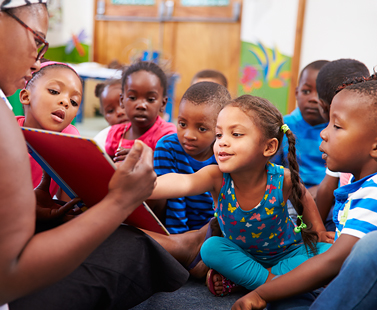5) How can I support my Multilingual Learners’ literacy development?
As children learn oral language, they also start to develop early literacy skills and to understand the connection between spoken language and print. For children of all language backgrounds, oral language and literacy development are closely related32, however, developing two languages simultaneously can lead to some unique developmental patterns for Multilingual Learner (ML) children. For example, research shows that emergent literacy skills in the home language can help facilitate parallel skills in English.33 This is called cross-language transfer. In addition, metalinguistic awareness, including the ability to recognize that other languages exist and have different characteristics, is important for reading development and is heightened in bilingual children.34 This finding is a key reason to foster literacy in both languages and to align literacy instruction across the languages. In doing so, teachers should maintain language separation, that is, consistent periods of instruction through each language.35 Teachers who speak the home language should pay extra attention to its characteristics. For example, the Roman alphabet is made up of letters that represent sounds, while the Chinese writing system is made up of characters that represent words or parts of words. Of course, using developmentally appropriate practices for literacy teaching in the language is key. Because oral language and literacy development are so connected, literacy strategies should be integrated with oral language strategies described in Question 4.
Sample Lesson Plan & Resource Walk
Access additional resources developed to introduce teachers to the work of literacy development. These activities, a sample lesson plan and a resource walk, are designed to support learning about this instructional topic area through structured exploration of resources on the website. Click the buttons below to access these resources.
Strategies in action



You can search across all strategies by keyword on our Research Search page. Give it a try!
Overarching Strategy: Build foundational reading skills in each language.
Evidence-Based Strategies
5A. Conduct phonological awareness activities that explicitly teach children to hear individual segments of sounds in words, such as using manipulatives to represent sound units (relevant for letter-based writing systems only).
TK
10-15 minutes
5-10 minutes
5B. Help children identify letters and develop awareness of letter-sound connections, that is, phonics (relevant for letter-based writing systems only).
5-10 minutes
5C. Provide instruction on book concepts and knowledge (particularly in preschool to support emergent literacy).
TK
10-15 minutes
Document
Website Article: Selecting Texts for Strategy Teaching with English Language Learners in Mind
5-10 minutes
TK
10-15 minutes
Overarching Strategy: Use shared reading activities to build oral language and reading comprehension skills in each language.
Evidence-Based Strategies
5D. Read text aloud with appropriate speed and expression to promote oral reading fluency.
5E. Conduct pre- and post-reading activities and discussions in each language to foster critical thinking skills and reading comprehension.
TK
10-15 minutes
TK
10-15 minutes
5F. Engage in interactive (dialogic) reading by asking open-ended questions, prompting children to retell narratives, and modeling and supporting language and content comprehension skills.
TK
More than 60 minutes
Video & Video Guide
Video & Video Guide: Using Reciprocal Teaching to Engage 3rd-Grade Readers
5-10 minutes
5G. Introduce and explain new vocabulary words before, during, or after reading.
5-10 minutes
TK
Under 5 minutes
5H. Read text in the home language first, and then follow up by reading the text in English over a period of time.
TK
10-15 minutes
5-10 minutes
TK
5-10 minutes
Video & Video Guide
Video: Model Curriculum for English Learners – Weathering and Erosion (3rd grade)
5-10 minutes
TK
10-15 minutes
Overarching Strategy: Provide consistent opportunities and appropriate scaffolds to engage children with writing in each language.
Evidence-Based Strategies
5I. Practice developmentally appropriate writing activities (pre-writing in preschool) in each language.
TK
5-10 minutes
10-15 minutes
TK
5-10 minutes
5-10 minutes
5J. Provide language-based supports (e.g., graphic organizers, sentence starters) to help children begin and develop writing.
TK
10-15 minutes
30-60 minutes
10-15 minutes
5-10 minutes
5-10 minutes
5K. Provide writing assignments that are content-based and help develop academic language as well as writing skills (elementary only).
TK
10-15 minutes
TK
More than 60 minutes
5-10 minutes
5-10 minutes
30-60 minutes
TK
5-10 minutes
10-15 minutes
Video & Video Guide
Video & Video Guide: Using Reciprocal Teaching to Engage 3rd-Grade Readers
5-10 minutes
5-10 minutes
5L. Develop student writing for a variety of genres and audiences, using appropriate content, organization, and style (elementary only).
5-10 minutes
5-10 minutes
10-15 minutes

Strategies are interrelated
Individual strategies across the different instructional topics are interconnected and should be implemented together, in a purposeful and connected manner throughout instruction, and not in isolation. Make sure to also consider your classroom or school’s language model when implementing the strategies and adapt accordingly
Visit how to use this site >

Alignment with Existing California Educator Guidance Documents & Resources
The Multilingual Learning strategies are closely aligned with existing guidance documents and resources for educators in California. Learn how Literacy Development strategies align with these existing resources, or to see how the standards align across all strategies, visit the alignment reference guide page.


